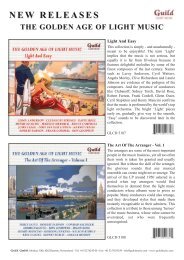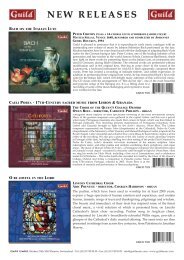Gabriella Swallow, Richard Bonynge and Sally Silver
Gabriella Swallow, Richard Bonynge and Sally Silver
Gabriella Swallow, Richard Bonynge and Sally Silver
Create successful ePaper yourself
Turn your PDF publications into a flip-book with our unique Google optimized e-Paper software.
other well-known composers, among them Fauré <strong>and</strong> Delibes.<br />
Massenet continued to write songs throughout his career. His choice of poets was wide-ranging,<br />
with several great literary names (eg. Victor Hugo, Anatole France <strong>and</strong> Alphonse de Lamartine) rubbing<br />
shoulders with less well-known writers. All his songs show great sensitivity to the setting of text, with<br />
melodic lines <strong>and</strong> piano accompaniments encapsulating the emotions of the poetry with great skill. There<br />
are simple, strophic songs with unobtrusive, non-melodic accompaniments (eg. Avril est amoureuse<br />
<strong>and</strong> Guitare); more complex, through-composed narratives (eg. Ma petite mère a pleuré <strong>and</strong> Sonnet);<br />
quiet, almost aphoristic expressions (eg. Crépuscule <strong>and</strong> Que l’heure est donc brève) contrasting with<br />
more extrovert, expansive songs (eg. Enchantement <strong>and</strong> Ivre d’amour) or even dramatic, quasi-operatic<br />
compositions (eg. Jamais plus!). His final proper cycle, Quelques chansons mauves, appeared in 1902 to<br />
three poems of André Lebey. This cycle shows an ever greater inventiveness <strong>and</strong> freedom in the word<br />
setting <strong>and</strong> open-ended musical forms. Phrases <strong>and</strong> even entire songs end harmonically inconclusively,<br />
<strong>and</strong> the vocal line ranges from a simple parl<strong>and</strong>o on one pitch to soaring melody where single syllables are<br />
drawn out over two bars.<br />
His last collection of songs, the Expressions lyriques were published in 1913, a year after his death.<br />
Here the word setting is at its most varied: lyrical style, recitative, melodrama or what Massenet called<br />
‘déclamation rythmée’, which seems to anticipate the Sprechstimme of Schoenberg. There is only one cycle<br />
on this disc, the short Quelques chansons mauves, most of the other songs being individual compositions.<br />
Two (Crépuscule <strong>and</strong> Que l’heure est donc brève) come from other cycles, the Ave Maria is based on the<br />
Méditation from Massenet’s opera Thaïs, <strong>and</strong> one, La Verdadera Vida, was completed by the composer<br />
Marc Berthomieu <strong>and</strong> not published until 1933.<br />
Although interest in Massenet’s music declined soon after his death, Manon, Werther <strong>and</strong> Thaïs have<br />
remained firm favorites in the opera repertoire. Esclarmonde is perhaps Massenet’s most ambitious work<br />
for the stage <strong>and</strong> is his most Wagnerian in style <strong>and</strong> scope. The opera has been revived sporadically in the<br />
modern era, most notably in 1974 in San Francisco, in 1976 at the Metropolitan Opera, New York <strong>and</strong><br />
in 1983 at the Royal Opera House in London with, on all occasions, Joan Sutherl<strong>and</strong> in the title role,<br />
conducted by her husb<strong>and</strong> <strong>and</strong> long term Massenet champion <strong>Richard</strong> <strong>Bonynge</strong>.<br />
Throughout his career <strong>Bonynge</strong> has conducted in most of the world’s leading opera houses.<br />
By doing some research <strong>and</strong> reading up on Massenet, <strong>Richard</strong> <strong>Bonynge</strong> discovered Massenet’s own statement<br />
about his opera Esclarmonde being his ”best achievement.” This filled <strong>Bonynge</strong> with curiosity, even more because<br />
Esclarmonde had sunken almost into total oblivion <strong>and</strong> had hardly been performed at all since the end of the 19th<br />
century. He obtained a vocal score of it in Paris <strong>and</strong> subsequently bought the full orchestral score from an auction<br />
in New York City. Although his wife, initially, was skeptical about it, <strong>Richard</strong> <strong>Bonynge</strong> became an enthusiast of<br />
the work <strong>and</strong> eventually convinced her that she should perform the role of ”Esclarmonde” herself. And so the San<br />
Francisco Opera, the Metropolitan Opera <strong>and</strong> the Royal Opera House Covent Garden premieres of it took place<br />
in 1974, 1976 <strong>and</strong> 1983 respectively.<br />
In 1977 he was the founding Music Director of Vancouver Opera Orchestra (at its creation), when he<br />
conducted Le Roi de Lahore staged there (in which also his wife took part).<br />
<strong>Bonynge</strong> made his Metropolitan Opera debut in 1966 with Joan Sutherl<strong>and</strong> performing the title role in Lucia<br />
di Lammermoor. Over the last five decades, <strong>Bonynge</strong> also performed with many of the word’s great singers. He<br />
worked extensively with Tebaldi, Caballé, Scotto, Te Kanawa, Gruberova, Horne, Bartoli, Cossotto, Berganza,<br />
Domingo, Pavarotti, Kraus, Bergonzi, Aragall, Corelli, Gobbi, Siepi, Milnes, Ghiaurov <strong>and</strong> Ramey, etc. In the<br />
beginning his speciality (until early 1970s) was music of 18th <strong>and</strong> early 19th century, mostly in bel canto repertoire<br />
(Rossini, Bellini <strong>and</strong> Donizetti). He then gradually added also middle Verdi (La Traviata, Rigoletto, Il Trovatore),<br />
Offenbach (Les Contes d’Hoffmann), then also Massenet (Esclarmonde <strong>and</strong> Werther). He has also recorded over<br />
50 operas as well as Delibes’s three ballets – La Source, Coppélia <strong>and</strong> Sylvia <strong>and</strong> Tchaikovsky’s three ballets – Swan<br />
Lake, The Sleeping Beauty <strong>and</strong> The Nutcracker plus countless others.<br />
Since 2007, he has conducted a series of performances in opera houses around the U.S. <strong>and</strong> performed<br />
regularly with Opera Australia where he was Musical Director from 1976 - 1986. During his tenure he introduced<br />
works previously unheard in the 20th century: Alcina, Semiramide, Les Huguenots, Lucrezia Borgia, Maria<br />
Stuarda, I Masnadieri, Dialogues of the Carmelites <strong>and</strong> Fra Diavolo. Over the past two years he has conducted a<br />
new production of Bellini’s La Sonnambula for Opera Australia, La Flûte Magique for the Cuban Ballet Festival<br />
<strong>and</strong> three Donizetti operas, Roberto Devereux, Maria Stuarda <strong>and</strong> Don Pasquale, in London <strong>and</strong> Athens <strong>and</strong><br />
returned to Sydney to conduct a concert version of H<strong>and</strong>el’s Rodelinda at the City Recital Hall Angel Place.<br />
<strong>Richard</strong> <strong>Bonynge</strong> was made a Comm<strong>and</strong>er of the Order of the British Empire (CBE) for his services to music<br />
in 1977. In 1983 he was made Officer of the Order of Australia, <strong>and</strong> in 1989 a Comm<strong>and</strong>eur de L’Ordre Natioanl<br />
des Arts et des Lettres. Made ”Socio d’onore”, R. Accademia Filarmonica di Bologna in 2007. In 2009 <strong>Bonynge</strong><br />
was awarded the Sir <strong>Richard</strong> Heinze Memorial Award <strong>and</strong> in 2010 the Patron’s Award within the Critics’ Circle<br />
4 25

















